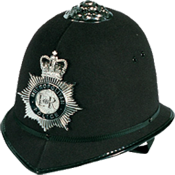
The Brodie helmet is a steel combat helmet designed and patented in London in 1915 by Latvian inventor John Leopold Brodie. A modified form of it became the Helmet, Steel, Mark I in Britain and the M1917 Helmet in the US. Colloquially, it was called the shrapnel helmet, battle bowler, Tommy helmet, tin hat, and in the United States the doughboy helmet. It was also known as the dishpan hat, tin pan hat, washbasin and Kelly helmet. The German Army called it the Salatschüssel. The term Brodie is often misused. It is correctly applied only to the original 1915 Brodie's Steel Helmet, War Office Pattern.

The Stahlhelm is a term used to refer to a series of German steel combat helmet designs intended to protect the wearer from common battlefield hazards such as shrapnel.

The M1 helmet is a combat helmet that was used by the U.S. military from World War II until 1985, when it was succeeded by the PASGT helmet. The M1 helmet has become an icon of the US military, with its design inspiring other militaries around the world.

The custodian helmet is a type of helmet worn predominantly by male police officers in the United Kingdom and within certain other places around the world. First used by the Metropolitan Police in London in 1863, the BBC labelled the custodian helmet a "symbol of British law enforcement". They are worn by male constables and sergeants on foot patrol. A cultural icon, it has featured in films, TV series and other media involving British police.

The following is a general overview of the Heer main uniforms, used by the German Army prior to and during World War II.

The M/1923 helmet was a combat helmet issued to Danish troops during the interwar period and saw service in the Second World War. It was the first helmet to be issued to the Royal Danish Army and Navy. The helmet was produced by the Danish company A/S Glud & Marstrands Fabrikker.
The OR-201, also designated Kasda OR-201 Model 76 or M-76 for short, is a combat helmet of Israeli origin. Developed in the 1970s, the OR-201 was one of the world's first ballistic helmets. It was subsequently exported on a large scale and has been used by many militaries worldwide.

The M59/M85 is a Yugoslav combat helmet which was produced between 1958–59 and 1985. They were commonly used in the Yugoslav Wars.

The Czechoslovak M53 helmet was used by the Czechoslovak Army from the early 1950s onward. In western European countries and the United States, it is sometimes referred to as the Czech M53 helmet. These helmets are commonly mistaken for, and sometimes marketed as, Soviet SSh-40 helmets, and various other very similar Eastern Bloc helmets.

The M32 helmet also known as M32/34 is a military steel combat helmet used by Czechoslovakia from its adoption in 1932 to its annexation by Nazi Germany in 1939. The helmet also being used by the Slovak Republic and Finland among other countries that the helmet would be worn by.

The M1918 helmet is a steel military combat helmet used by Switzerland from its introduction in 1918 to its replacement by the M1971. In 1943 improvements would be made to the design to which it would be called the M1918/40. The helmet would be seen used by Swiss servicemen until the late 20th century.

The M1971 helmet is a military steel combat helmet used by Switzerland from its formal introduction in 1971 until its gradual replacement by the Schuberth B826.

The M1942 helmet is a military steel combat helmet used by Spain from its adoption in 1942 to its replacement by a Spanish M1 copy in the 1980s.

The M1926 Helmet, also known as the M26 and “Con ala” for its flared sides compared to the earlier M1921 model helmet, is a steel combat helmet used by Spain from its adoption in 1930 until its replacement by the M42 in 1942. The helmet would be a common sight along with many other helmets between both sides in the Spanish Civil War.

The M1921 Helmet, also known as the M21, along with “Sin ala” for its vertical sides, is a steel combat helmet developed alongside the M1926 helmet in 1926 for use by the Spanish Army. The model was never formally adopted, with the army deciding in favor of the M1926. The exact reasoning for the designation "M1921" is not known as it was developed later.

The M70 is a steel combat helmet used by Hungary, a license made copy of the Soviet SSh-40 and further development of the previous model M50 helmet.

The M1934 helmet is a steel combat helmet used by various factions in the Spanish Civil War. Not meant for use by the Spanish Army, but instead by security forces such as police, the helmet was of similar shape to the Model 1926 helmet in use by the army. The helmet was mainly used by the rebelsFrancoist in the conflict.

The Wz50 also known as M50 is a steel combat helmet used by Poland from its introduction in 1950 to its replacement by the Hełm wz. 67 in 1967. The helmet would be widely exported to a number of Arab countries for its low price. Early pre-production helmets by a double riveted chinstrap and cow skin leather liner. All models of helmet would include an maker and manufacture stamp

The Model 1973 is a Romanian steel helmet used by the army of Romania, introduced in 1973 in the Army of the Socialist Republic of Romania.

The Hełm wz. 67 is a combat helmet used in the Polish People's Army and in the Polish Armed Forces.





















